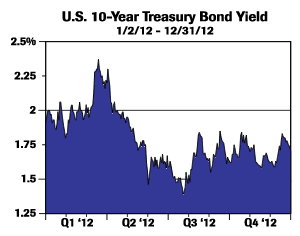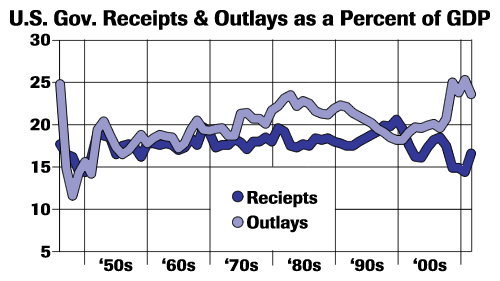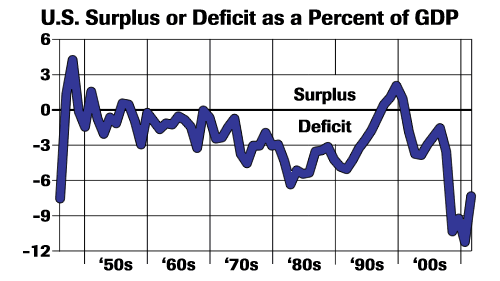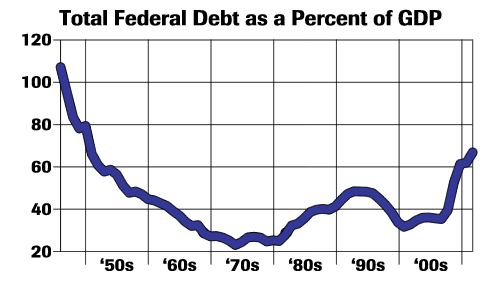2012 Q4 | Saved by the Bell—Again
 Despite an acrimonious, bordering on uncivilized, debate between the executive and legislative branches of the government, a major tax reform bill was passed and signed into law in the predawn hours of January 2nd. Regardless of when the legislation was signed, it appears our nation has avoided a journey into an economic twilight zone known as the “fiscal cliff.”
Despite an acrimonious, bordering on uncivilized, debate between the executive and legislative branches of the government, a major tax reform bill was passed and signed into law in the predawn hours of January 2nd. Regardless of when the legislation was signed, it appears our nation has avoided a journey into an economic twilight zone known as the “fiscal cliff.”
The eleventh-hour rescue appears to have temporarily avoided a crisis, but virtually no party to the legislation is satisfied with the outcome. Some would say that the can was again kicked down the road, and major issues remain. Sometime in the first quarter of 2013, perhaps as early as March 1st, additional authorizations will be necessary to increase the Federal debt limit, which created a near-crisis in August of 2011 when it was last addressed. The consequence of that crisis was the loss of the country’s AAA bond rating, and it appears this debt limit problem will be every bit as contentious as that of 18 months ago. Be assured that the hostile environment in Washington associated with economic issues will be with us for quite some time.
Overlooked in the collective sigh of relief associated with avoidance of falling off the cliff was the fact that the tax bill did not address any substantive spending cuts. To expect our projected deficits of $1 trillion or more annually to be closed solely by tax increases is both naïve and unreasonable. Many years ago, a smart economist noted, “No amount of tax increases could balance any government budget.” Indeed, we saw surpluses only after the Clinton administration instituted a cut on capital gains taxes in 1997. Some believe the favorable treatment of investment through lower capital gains rates played an important role in fueling the economic expansion of the late 1990’s, which in turn resulted in three years of $100 billion+ surpluses.
[blockquote4=”left|center|right” textalign=”left|center|right” width=”30%”]Virtually no party to the legislation is satisfied with the outcome. [/blockquote4]Today’s good news is that the fiscal debate for the moment is over, and this will certainly calm the markets and give our country a rest from the gridlock in Washington. If this results in a sharp pickup in economic activity, a surge in tax collection could lower the deficit as a percentage of gross domestic product (GDP) and at least temporarily enable the deficit to be reduced.
As 2012 came to a close, the economy moved forward at an accelerating rate of 3.1%, extending the recovery that began in the first quarter of 2009. Our outlook calls for further moderate real growth of approximately 2% in real gross domestic product in 2013, certainly a below average recovery in comparison to historical standards. Consumer confidence and the economy strengthened in the second half of 2012, giving us optimism for continued growth in 2013.
Additionally, President Obama was reelected with a clear victory in the Electoral College and historically this has been welcomed by a stock market rally. However, this year’s celebration rally was affected by the rapidly approaching fiscal cliff. Nevertheless, in the fourth quarter the S&P 500’s total return was -.4%, bringing the full year’s total return to 16.0%, a good year when related to the historical performance of common stocks.
[blockquote4 align=”left|center|right” textalign=”left|center|right” width=”30%”] No amount of tax increases could balance any government budget. [/blockquote4]Our economy gave several very promising signs that the recovery from the 2008/09 recession was gaining momentum. Specifically, housing starts, resale of existing homes, foreclosure rates, and houses recently put under contract all showed meaningful improvement in 2012. Accounting for approximately 17% of our economy (~5% residential investment and ~12% housing services), the housing industry is a leading sector of the economy, and this further increases our confidence that the recession is at last over. Unfortunately, some of the recent improvement in the housing industry has been fueled by Hurricane Sandy, which hit the east coast on October 29th. New York and New Jersey were hardest hit, and the states are seeking about $80 billion in total Federal aid. The associated rebuilding expenses of Sandy will almost certainly contribute to further strength in the building sector in 2013.
Another major component of the economy, the healthcare industry, accounting for 12% of the S&P 500, should continue its historically steady growth in 2013. Every day, 10,000 baby boomers become eligible for Medicare, amounting to what will be 3.6 million new participants this year alone. Also, the first phases of Obamacare will take effect in 2013, which should increase demand for medical services. Although there are other challenges in implementing this program, including shortages in doctors and medical personnel, most of these issues are several years away from being front-burner concerns.
The energy industry, 11% of the S&P 500, is likely to enjoy strong growth in the coming years. There appears to be a real chance that US energy needs could be 100% supplied by North American sources by 2025. New technologies, including horizontal drilling, enhanced recovery techniques from fracking, and production of oil from shale using new methods all enabled 2012 domestic hydrocarbon production to reach its highest levels in over 20 years. Further significant gains are anticipated for the foreseeable future.
[blockquote4 align=”left|center|right” textalign=”left|center|right” width=”30%”] This latest monetary policy shuffle bears close watching. [/blockquote4]Several key industries that track closely to the economy, including consumer discretionary goods (11% of the S&P 500), industrials (10%) and technology (19%), should recover as the expected pickup in GDP growth continues at least through 2014.
The recovery in the financial sector, comprising 15% of the S&P 500, has accelerated recently as stimulative credit policies of the Federal Reserve are finally contributing to economic growth. Several times in 2012, Fed Chairman Bernanke reiterated his commitment to lower interest rates, keyed to inflation levels remaining below 2.5%. Somewhat surprisingly, in December, Mr. Bernanke added a second metric to his operating plan, calling for rates to remain low until unemployment reaches 6.5%. In order to achieve both of these goals, the Fed will inject $85 billion monthly into our financial system, which will increase the balance sheet of the United States from $2.8 trillion of assets to just under $4 trillion by year-end 2013. This program is designed to accelerate the economic growth of the country while bringing down unemployment rates and maintaining low levels of inflation—a very tall order. We have been concerned with ballooning Federal debt levels, but this latest monetary policy shuffle bears close watching, which will be reflected in a possible uptick in inflation levels.
Overall, our outlook remains positive for continued expansion in 2013, which could lead to a lowered unemployment rate, moderate inflation rates, and modest real growth in gross domestic product of 2.0%.
 Developing our stock market forecast for 2013, we believe S&P 500 earnings can increase at about a 6% rate to $107 to $110 per share. Applying a price/earnings multiplier of 14-15 times earnings, the market index could range between 1500 and 1650, the center point being 11% above its current level. This year’s earnings forecast involves somewhat more uncertainty, which in turn impacts our confidence in our terminal pricing. In recent quarters, expected earnings forecasts have been achieved despite the fact that revenue estimates have fallen short of expectations. This has resulted from expanding profit margins to cover the revenue shortfalls. Sooner or later, revenue growth must improve if stronger earnings expectations are to materialize, and this in turn will require a continuation and even acceleration in the growth of the economy in 2013.
Developing our stock market forecast for 2013, we believe S&P 500 earnings can increase at about a 6% rate to $107 to $110 per share. Applying a price/earnings multiplier of 14-15 times earnings, the market index could range between 1500 and 1650, the center point being 11% above its current level. This year’s earnings forecast involves somewhat more uncertainty, which in turn impacts our confidence in our terminal pricing. In recent quarters, expected earnings forecasts have been achieved despite the fact that revenue estimates have fallen short of expectations. This has resulted from expanding profit margins to cover the revenue shortfalls. Sooner or later, revenue growth must improve if stronger earnings expectations are to materialize, and this in turn will require a continuation and even acceleration in the growth of the economy in 2013.
The ten-year U.S. Treasury rates trended downward throughout 2012 as shown in the accompanying table. This gradual decline was the result of the Federal Reserve continuing to pursue its stimulative monetary policies of the last three years, which were closely shadowing the favorable inflation experience of that time. Business borrowing costs, mortgage rates, and term lending rates are all at record or nearly record post World War Two lows, yet business activity remains stubbornly sluggish. Lending institutions, in part restrained by uncertain provisions of the Dodd-Frank financial reform act, have been very reluctant to approve new loans, except for the most creditworthy of clients.
[blockquote4 align=”left|center|right” textalign=”left|center|right” width=”30%”] The major risk confronting our economy is the ongoing gridlock in Washington.[/blockquote4]Given the Federal Reserve’s new quantification of interest rate targeting using both inflation and the unemployment rate, we expect the ten-year Treasury to trade in a range of 1.5% to 2.2% next year, unless the economy picks up sharply and unemployment levels fall precipitously. Unfortunately, this would suggest a rapid increase in the level of inflation. We rate this outcome as a remote possibility, but should it occur, even a 1% increase in the ten-year Treasury rate (presently 1.76%) would result in an 8% decline in the ten-year bond, eliminating five years of the coupon return!
As we enter 2013, we are optimistic that the anemic economic recovery from the 2008-09 recession caused by the financial crisis has turned decisively upward and begun to gain momentum— at last. In addition, there are early signs of a recovery in the European stock markets, often a leading economic indicator that could suggest improvement in one of the most economically troubled regions of the world.
There are two critical issues our nation faces: debt as a percentage of our GDP and the percentage of GDP that is attributable to the federal government. As detailed in the charts on the following page, each of these economic series are at levels well above historic norms and pose a major challenge to our economic well being in the future.
In reviewing the sharp increase in debt levels relative to our GDP between 2003 and 2012, it should be obvious this trend cannot continue indefinitely. The sharp increases that occurred between 2009 and 2011 are in part because of the severity of the recession resulting from the financial crisis of 2008-09. Normally, the more severe the recession, the more rapid the recovery. Yet this pattern did not manifest itself in this cycle, likely because of the liquidity shock associated with the bankruptcy of Lehman Brothers and Bear Stearns. This shock, in turn, created a market panic, which required emergency measures by the Federal Reserve. Soon, it should become necessary to reverse these actions to restore debt to more normal levels.



Also contributing to a false sense of security is that interest rates on government debt are at their lowest rates in history. This dynamic has enabled the government to borrow at very favorable rates, sending the message that debt is being serviced easily, when in fact it is not. Assuming that interest rates were to increase by 2 percentage points, the increased borrowing cost would add ~$320 billion (or 2%) to the government deficit.
Another critical issue facing our economy has been the sharp increase in the percentage of gross domestic product attributable to government spending. This has occurred in part due to the recession, which required sharp increases in “safety net” expenditures, such as unemployment benefits and food stamps. As the economy recovers, these costs, a bit less than 1% of GDP, will fall significantly. However, it appears that normalized government spending has risen from the post-war average of about 21% of GDP to about 24% of GDP. This 3% rise translates into $500 billion of additional annual federal spending. Herein lies the conflict between the Obama administration and Republican Party. The Administration proposes to shrink the private sector’s percentage of the economy by roughly 3% and transfer it to the government sector. The question to be debated is which is the most efficient way of allocating the resources of our economy.
So we enter 2013 with high hopes for stocks, especially if concerns posed by the fiscal impasse in Washington further abate. Our caution on the outlook for bond prices continues, and we would recommend fixed income positions remain at the lowest level prescribed in each individual client’s investment policy statement. The major risk confronting our economy is the ongoing gridlock in Washington. The gridlock could threaten our outlook if it snarls the extension of the debt ceiling. This issue must be addressed fully sometime before June 30th. Having just come through the pain of a hard-fought battle over the fiscal cliff, perhaps the combatants will realize a more civil approach to funding our government can and must be developed.
With so many positive things occurring in our economy, it would be tragic if discord in the government would abort the recovery. We hope for and expect a happy new year.



